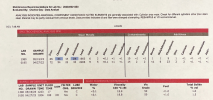I've been trying to purchase a PA28 for about a month. I've been through two prebuys with issues each time.
But, I kept on and found one that made sense for my budget and mission, but the plane sat for 18 years from 2003 - 2021. Since then, someone bought it and put it back into service. They've flown ~35 tach hours the past two years total looking at the annuals. The seller said they've had two cylinders off in the last two years, but the engine looked good.
Along with the logs, they supplied this oil analysis below:
Give the oil analysis results, with the wear metals being high, would this be enough to keep you from moving forward with the purchase?
But, I kept on and found one that made sense for my budget and mission, but the plane sat for 18 years from 2003 - 2021. Since then, someone bought it and put it back into service. They've flown ~35 tach hours the past two years total looking at the annuals. The seller said they've had two cylinders off in the last two years, but the engine looked good.
Along with the logs, they supplied this oil analysis below:

Give the oil analysis results, with the wear metals being high, would this be enough to keep you from moving forward with the purchase?
